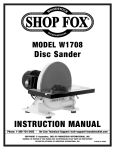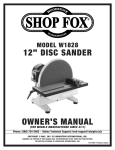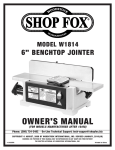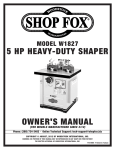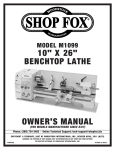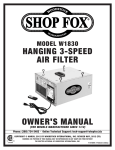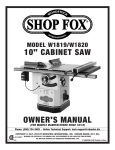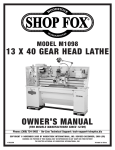Download Woodstock W1708 Specifications
Transcript
MODEL W1708 12" DISC SANDER OWNER'S MANUAL (FOR MODELS MANUFACTURED SINCE 10/07) Phone: (360) 734-3482 • Online Technical Support: [email protected] COPYRIGHT © SEPTEMBER, 2003 BY WOODSTOCK INTERNATIONAL, INC. REVISED, OCTOBER, 2009 (BL) #5488EW WARNING: NO PORTION OF THIS MANUAL MAY BE REPRODUCED IN ANY SHAPE OR FORM WITHOUT THE WRITTEN APPROVAL OF WOODSTOCK INTERNATIONAL, INC. Printed in China K_`jdXelXcgifm`[\jZi`k`ZXcjX]\kp`ejkilZk`fejfek_\gifg\ij\klg# fg\iXk`fe#dX`ek\eXeZ\Xe[j\im`Z\f]k_`jdXZ_`e\&\hl`gd\ek% =X`cli\kfi\X[#le[\ijkXe[Xe[]fccfnk_\`ejkilZk`fej^`m\e`ek_`j dXelXcdXpi\jlck`ej\i`fljg\ijfeXc`ealip#`eZcl[`e^XdglkXk`fe# \c\ZkifZlk`fefi[\Xk_% K_\fne\if]k_`jdXZ_`e\&\hl`gd\ek`jjfc\cpi\jgfej`Yc\]fi`kjjX]\ lj\%K_`ji\jgfej`Y`c`kp`eZcl[\jYlk`jefkc`d`k\[kfgifg\i`ejkXccX$ k`fe`eXjX]\\em`ifed\ek#g\ijfee\ckiX`e`e^Xe[ljX^\Xlk_fi`qX$ k`fe#gifg\i`ejg\Zk`feXe[dX`ek\eXeZ\#dXelXcXmX`cXY`c`kpXe[ Zfdgi\_\ej`fe#Xggc`ZXk`fef]jX]\kp[\m`Z\j#YcX[\&Zlkk\i`ek\^i`kp# Xe[k_\ljX^\f]g\ijfeXcgifk\Zk`m\\hl`gd\ek% K_\dXel]XZkli\in`ccefkY\_\c[c`XYc\]fi`ealipfigifg\ikp [XdX^\]ifde\^c`^\eZ\#`dgifg\ikiX`e`e^#dXZ_`e\df[`]`ZXk`fejfi d`jlj\% Jfd\[ljkZi\Xk\[Ypgfn\ijXe[`e^#jXn`e^#^i`e[`e^#[i`cc`e^#Xe[ fk_\iZfejkilZk`feXZk`m`k`\jZfekX`ejZ_\d`ZXcjbefnekfk_\JkXk\f] :Xc`]fie`XkfZXlj\ZXeZ\i#Y`ik_[\]\Zkjfifk_\ii\gif[lZk`m\_Xid% Jfd\\oXdgc\jf]k_\j\Z_\d`ZXcjXi\1 C\X[]ifdc\X[$YXj\[gX`ekj% :ipjkXcc`e\j`c`ZX]ifdYi`Zbj#Z\d\ekXe[fk_\idXjfeipgif[lZkj% 8ij\e`ZXe[Z_ifd`ld]ifdZ_\d`ZXccp$ki\Xk\[cldY\i% Pflii`jb]ifdk_\j\\ogfjli\jmXi`\j#[\g\e[`e^fe_fnf]k\epfl [fk_`jkpg\f]nfib%Kfi\[lZ\pfli\ogfjli\kfk_\j\Z_\d`ZXcj1 Nfib`eXn\ccm\ek`cXk\[Xi\X#Xe[nfibn`k_Xggifm\[jX]\kp\hl`g$ d\ek#jlZ_Xjk_fj\[ljkdXjbjk_XkXi\jg\Z`Xccp[\j`^e\[kf]`ck\i flkd`ZifjZfg`ZgXik`Zc\j% SAFETY................................................4 Standard Machinery Safety...................... 4 Additional Safety for Disc Sanders............. 6 SERVICE............................................. 22 Troubleshooting.................................. 22 Table/Disc Parallelism.......................... 24 Miter Gauge Calibration........................ 25 Table Tilt Calibration........................... 26 Electrical Safety Instructions.................. 27 Wiring Diagram.................................. 28 PARTS............................................... 29 Main Breakdown................................. 29 Main Parts List................................... 30 WARRANTY......................................... 33 OPERATIONS MAINTENANCE OPERATIONS....................................... 13 General........................................... 13 Basic Controls.................................... 14 Operation Overview............................ 14 Sanding Tips...................................... 15 Choosing Sandpaper............................ 16 Stock Inspection and Requirements.......... 16 Attaching Sandpaper............................ 17 Disc Sanding...................................... 18 Miter Sanding.................................... 18 Angle Sanding.................................... 19 SET UP SETUP.................................................8 Needed for Setup................................. 8 Unpacking.......................................... 8 Inventory........................................... 8 Cleanup............................................. 9 Site Considerations............................. 10 Mounting.......................................... 11 Dust Collection.................................. 11 Test Run........................................... 12 MAINTENANCE..................................... 21 General........................................... 21 Cleaning.......................................... 21 Unpainted Cast Iron............................ 21 Lubrication....................................... 21 ELECTRICAL ELECTRICAL..........................................7 110V Operation.................................... 7 Extension Cords................................... 7 Electrical Specifications......................... 7 Power Connection Device........................ 7 ACCESSORIES....................................... 20 Disc Sander Accessories........................ 20 SAFETY INTRODUCTION......................................2 Woodstock Technical Support................... 2 Specifications...................................... 2 INTRODUCTION Contents SERVICE PARTS USE THE QUICK GUIDE PAGE LABELS TO SEARCH OUT INFORMATION FAST! INTRODUCTION W1708 Owner's Manual (Mfg. 10/07+) INTRODUCTION Woodstock Technical Support This machine has been specially designed to provide many years of trouble-free service. Close attention to detail, ruggedly built parts and a rigid quality control program assure safe and reliable operation. Woodstock International, Inc. is committed to customer satisfaction. Our intent with this manual is to include the basic information for safety, setup, operation, maintenance, and service of this product. We stand behind our machines! In the event that questions arise about your machine, please contact Woodstock International Technical Support at (360) 734-3482 or send e-mail to: tech-support@shopfox. biz. Our knowledgeable staff will help you troubleshoot problems and process warranty claims. If you need the latest edition of this manual, you can download it from http://www.shopfox.biz. If you have comments about this manual, please contact us at: Woodstock International, Inc. Attn: Technical Documentation Manager P.O. Box 2309 Bellingham, WA 98227 Email: [email protected] Specifications Machine Product Weight.......................................................................................... 68 lbs. Machine Shipping Weight.......................................................................................... 74 lbs. Footprint.................................................................................................... 13" W x 10" D Power Requirement.......................................................................... 110V, Single Phase, 60 Hz Switch..................................................................... Paddle ON/OFF Switch, w/Safety Lock Key Motor.................................................................................................... 1 HP, 110V, 60 Hz Motor Speed.....................................................................................................1725 RPM Amps..................................................................................................................... 10A Power Transfer...............................................................................................Direct Drive Sanding Disc.............................................................................................................12" Disc Speed.......................................................................................................1725 RPM Table Dimensions............................................................................................ 171/2" x 81/4" Bearings.............................................................................. Sealed, Permanently Lubricated Paint....................................................................................................... Powder Coated Dust Port.................................................................................................................. 2" -2- INTRODUCTION W1708 Owner's Manual (Mfg. After 10/07+) Controls and Features Precision-Ground Cast Aluminum Disc (Sanding Disc Attached) Disc Guard Motor Miter Gauge Work Table ON/OFF Switch Base Table Lock Handle Dust Port Foot To reduce the risk of serious injury when using this machine, read and understand this entire manual before beginning any operations. -3- W1708 Owner's Manual (Mfg. 10/07+) SAFETY SAFETY Standard J8=<KP Machinery Safety I<8;D8EL8C9<=FI<FG<I8K@E>D8:?@E<% =8@CLI<KF=FCCFN@EJKIL:K@FEJ9<CFNN@CC I<JLCK@EG<IJFE8C@EALIP% @e[`ZXk\jXe`dd`e\ekcp_XqXi[fljj`klXk`fen_`Z_#`]efkXmf`[\[#N@CC i\jlck`e[\Xk_fij\i`flj`ealip% @e[`ZXk\jXgfk\ek`Xccp_XqXi[fljj`klXk`fen_`Z_#`]efkXmf`[\[#:FLC; i\jlck`e[\Xk_fij\i`flj`ealip% @e[`ZXk\jXgfk\ek`Xccp_XqXi[fljj`klXk`fen_`Z_#`]efkXmf`[\[#D8P i\jlck`ed`efifidf[\iXk\`ealip% EFK@:< K_`jjpdYfc`jlj\[kfXc\ikk_\lj\ikflj\]lc`e]fidXk`feXYflkgifg\i fg\iXk`fef]k_\\hl`gd\ek#Xe[&fiXj`klXk`fek_XkdXpZXlj\[XdX^\ kfk_\dXZ_`e\ip% JkXe[Xi[JX]\kp@ejkilZk`fej (% I<8;K?IFL>?K?<<EK@I<D8EL8C9<=FI<JK8IK@E>D8:?@E<IP%DXZ_`e\ipgi\j\ekjj\i`flj `ealip_XqXi[jkflekiX`e\[lj\ij% )% 8CN8PJ LJ< 8EJ@ 8GGIFM<; J8=<KP >C8JJ<J N?<E FG<I8K@E> D8:?@E<IP% <m\ip[Xp \p\$ ^cXjj\jfecp_Xm\`dgXZki\j`jkXekc\ej\jÇk_\pXi\EFKjX]\kp^cXjj\j% *% 8CN8PJN<8I8E@FJ?8GGIFM<;I<JG@I8KFIN?<EFG<I8K@E>D8:?@E<IPK?8KGIF;L:<J ;LJK%Nff[[ljk`jXZXiZ`ef^\eXe[ZXeZXlj\ZXeZ\iXe[j\m\i\i\jg`iXkfip`cce\jj\j% +% 8CN8PJ LJ< ?<8I@E> GIFK<:K@FE N?<E FG<I8K@E> D8:?@E<IP% DXZ_`e\ip ef`j\ ZXe ZXlj\ g\idXe\ek_\Xi`e^[XdX^\% ,% N<8IGIFG<I8GG8I<C%;FEFKn\Xicffj\Zcfk_`e^#^cfm\j#e\Zbk`\j#i`e^j#fia\n\cipn_`Z_dXp ^\k ZXl^_k `e dfm`e^ gXikj% N\Xi gifk\Zk`m\ _X`i Zfm\i`e^ kf ZfekX`e cfe^ _X`i Xe[ n\Xi efe$jc`g ]ffkn\Xi% -% E<M<IFG<I8K<D8:?@E<IPN?<EK@I<;#FILE;<IK?<@E=CL<E:<F=;IL>JFI8C:F?FC% 9\d\ekXccpXc\ikXkXcck`d\jn_\eilee`e^dXZ_`e\ip% .% FECP8CCFNKI8@E<;8E;GIFG<ICPJLG<IM@J<;G<IJFEE<CKFFG<I8K<D8:?@E<IP%DXb\ jli\fg\iXk`fe`ejkilZk`fejXi\jX]\Xe[Zc\Xicple[\ijkff[% /% B<<G:?@C;I<E8E;M@J@KFIJ8N8P%B\\gXccZ_`c[i\eXe[m`j`kfijXjX]\[`jkXeZ\]ifdk_\nfib Xi\X% 0% D8B<NFIBJ?FG:?@C;GIFF=%Lj\gX[cfZbj#dXjk\ijn`kZ_\j#Xe[i\dfm\jkXikjn`kZ_b\pj% -4- W1708 Owner's Manual (Mfg. 10/07+) ('% E<M<IC<8M<N?<ED8:?@E<@JILEE@E>%Kliegfn\iF==Xe[XccfnXccdfm`e^gXikjkfZfd\kf XZfdgc\k\jkfgY\]fi\c\Xm`e^dXZ_`e\leXkk\e[\[% ((% ;FEFKLJ<@E;8E><IFLJ<EM@IFED<EKJ%;FEFKlj\dXZ_`e\ip`e[Xdg#n\kcfZXk`fej#fi n_\i\Xep]cXddXYc\fiefo`flj]ld\jdXp\o`jk% (*% LJ<8>IFLE;<;<OK<EJ@FE:FI;I8K<;=FIK?<D8:?@E<8DG<I8><%Le[\ij`q\[Zfi[jfm\i$ _\XkXe[cfj\gfn\i%I\gcXZ\\ok\ej`feZfi[j`]k_\pY\Zfd\[XdX^\[%;FEFKlj\\ok\ej`feZfi[j ]fi))'MdXZ_`e\ip% (+% 8CN8PJ;@J:FEE<:K=IFDGFN<IJFLI:<9<=FI<J<IM@:@E>D8:?@E<IP%DXb\jli\jn`kZ_`j `eF==gfj`k`feY\]fi\i\Zfee\Zk`e^% (,% D8@EK8@ED8:?@E<IPN@K?:8I<%B\\gYcX[\jj_XigXe[Zc\Xe]fiY\jkXe[jX]\jkg\i]fidXeZ\% =fccfn`ejkilZk`fej]ficlYi`ZXk`e^Xe[Z_Xe^`e^XZZ\jjfi`\j% (-% D8B<JLI<>L8I;J8I<@EGC8:<8E;NFIB:FII<:KCP9<=FI<LJ@E>D8:?@E<IP% (.% I<DFM< 8;ALJK@E> B<PJ 8E; NI<E:?<J% DXb\ X _XY`k f] Z_\Zb`e^ ]fi b\pj Xe[ X[aljk`e^ ni\eZ_\jY\]fi\klie`e^dXZ_`e\ipFE% (/% :?<:B =FI ;8D8><; G8IKJ 9<=FI< LJ@E> D8:?@E<IP% :_\Zb ]fi Y`e[`e^ Xe[ Xc`^ed\ek f] gXikj#Yifb\egXikj#gXikdflek`e^#cffj\Yfckj#Xe[Xepfk_\iZfe[`k`fejk_XkdXpX]]\ZkdXZ_`e\ fg\iXk`fe%I\gX`ifii\gcXZ\[XdX^\[gXikj% (0% LJ<I<:FDD<E;<;8::<JJFI@<J%I\]\ikfk_\`ejkilZk`fedXelXc]fii\Zfdd\e[\[XZZ\jjfi`\j% K_\lj\f]`dgifg\iXZZ\jjfi`\jdXpZXlj\i`jbf]`ealip% )'%;FEFK=FI:<D8:?@E<IP%NfibXkk_\jg\\[]fin_`Z_k_\dXZ_`e\fiXZZ\jjfipnXj[\j`^e\[% )(% J<:LI< NFIBG@<:<% Lj\ ZcXdgj fi X m`j\ kf _fc[ k_\ nfibg`\Z\ n_\e giXZk`ZXc% 8 j\Zli\[ nfibg`\Z\gifk\Zkjpfli_Xe[jXe[]i\\jYfk__Xe[jkffg\iXk\k_\dXZ_`e\% ))% ;FEFKFM<II<8:?%B\\ggifg\i]ffk`e^Xe[YXcXeZ\XkXcck`d\j% )*% D8EPD8:?@E<JN@CC<A<:KK?<NFIBG@<:<KFN8I;K?<FG<I8KFI%BefnXe[Xmf`[Zfe[`$ k`fejk_XkZXlj\k_\nfibg`\Z\kfb`ZbYXZb% )+% 8CN8PJCF:BDF9@C<98J<J@=LJ<; 9<=FI<FG<I8K@E>D8:?@E<IP% ),% 9< 8N8I< K?8K :<IK8@E ;LJK D8P 9< ?8Q8I;FLJ kf k_\ i\jg`iXkfip jpjk\dj f] g\fgc\ Xe[ Xe`dXcj#\jg\Z`Xccp]`e\[ljk%DXb\jli\pflbefnk_\_XqXi[jXjjfZ`Xk\[n`k_k_\kpg\f][ljkpfl n`ccY\\ogfj\[kfXe[XcnXpjn\XiXi\jg`iXkfiXggifm\[]fik_Xkkpg\f][ljk% -5- SAFETY ()% B<<GNFIB8I<8:C<8E8E;N<CCC@K%:clkk\iXe[[Xibj_X[fnjdXpZXlj\XZZ`[\ekj% W1708 Owner's Manual (Mfg. 10/07+) SAFETY Additional Safety for Disc Sanders READ and understand this entire manual before using this machine. Serious personal injury may occur if safety and operational information is not understood and followed. DO NOT risk your safety by not reading! Use this and other machinery with caution and respect. Always consider safety first, as it applies to your individual working conditions. No list of safety guidelines can be complete—every shop environment is different. Failure to follow guidelines could result in serious personal injury, damage to equipment or poor work results. 1. RESPIRATOR AND SAFETY GLASSES. Always wear a respirator and safety glasses while operating the machine. Dust and chips are created when sanding. Some debris will be ejected, becoming hazards to the eyes and lungs. 2. DUST COLLECTION SYSTEM. Never operate the sander without an adequate dust collection system in place and running. 3. CLOTHING. DO NOT wear loose clothing while operating this machine. Roll up or button sleeves at the cuff. 4. HAND PROTECTION. DO NOT place hands near, or in contact with, sanding disc during operation. DO NOT allow fingers to get pinched between the workpiece and the table. This may pull the operator’s hand into the machine and cause serious injury! 5. MINIMUM STOCK DIMENSIONS. Do not sand any stock thinner than 1⁄16", narrower than 1⁄8", or shorter than 9". 6. INSPECTING WORKPIECES. Always inspect workpiece for nails, staples, knots, and other imperfections that could be dislodged and thrown from the machine during sanding operations. 7. FEEDING STOCK. Firmly grasp the workpiece in both hands and ease it into the machine using light pressure. DO NOT jam the workpiece into the machine during operation. Feed the workpiece against the direction of rotation. DO NOT sand tapered or pointed stock with the point facing the feed direction. Never sand more than one piece of stock at a time. 8. UNATTENDED OPERATION. Never leave the machine running unattended. 9. REPLACING SANDPAPER. Replace sanding paper when it becomes worn. DO NOT operate the sander with a damaged or badly worn sandpaper. 10. MAINTENANCE AND ADJUSTMENTS. Perform machine inspections and maintenance service promptly when called for. Disconnect power before performing maintenance or adjustments on the sander. 11. EXPERIENCING DIFFICULTIES. Any problem that is concerned with any moving parts or accessories, must be investigated and corrected with the power disconnected, and after all moving parts have come to a complete stop. -6- W1708 Owner's Manual (Mfg. 10/07+) ELECTRICAL The machine must be properly set up before it is safe to operate. DO NOT connect this machine to the power source until instructed to do so in the "Test Run" portion of this manual. Power Connection Device This machine comes with a plug, similar to Figure 1, to connect the machine to power. ELECTRICAL 110V Operation The Model W1708 is wired for 110V operation. The power supply circuit used for this machine MUST be grounded and rated for the amperage given below. Never replace a circuit breaker with one of higher amperage without consulting a qualified electrician to ensure compliance with wiring codes. This machine must be grounded! The electrical cord supplied with this machine comes with a grounding pin. If your outlet does not accommodate a ground pin, have it replaced by a qualified electrician. Figure 1. 5-15 plug and receptacle. If you are unsure about the wiring codes in your area or you plan to connect your machine to a shared circuit, you may create a fire or circuit overload hazard—consult a qualified electrician to reduce this risk. Extension Cords We do not recommend using an extension cord; however, if you have no alternative, use the following guidelines: • • • • Use a cord rated for Standard Service (S). Do not use an extension cord longer than 50 feet. Ensure that the cord has a ground wire and pin. Use the gauge size listed below as a minimum. DO NOT work on your electrical system if you are unsure about electrical codes and wiring! Seek assistance from a qualified electrician. Ignoring this warning can cause electrocution, fire, or machine damage. Electrical Specifications Operating Voltage Amp Draw Min. Circuit Size Plug/Recommended Plug Extension Cord 110V Operation 10 Amps 15A NEMA 5-15 14 Gauge -7- W1708 Owner's Manual (Mfg. 10/07+) SETUP Needed for Setup The following are needed to complete the setup process, but are not included with your machine. SETUP Description Qty • Safety Glasses...............................................1 • Cleaner/Degreaser............................. As Needed • Disposable Shop Rags.......................... As Needed • Additional People...........................................1 • Dust Hose 2" ................................................1 • Dust Hose Clamp 2"........................................1 • Adapter 4" x 2" (Optional)................................1 • Dust Hose 4" (Optional)....................................1 • Dust Hose Clamp 4" (Optional)...........................1 • Mounting Hardware............................ As Needed Keep machine disconnected from power until instructed otherwise. Unpacking This machine has been carefully packaged for safe transportation. If you notice the machine has been damaged during shipping, please contact your authorized Shop Fox dealer immediately. Inventory The following is a description of the main components shipped with the Model W1708. Lay the components out to inventory them. A Note: If you can't find an item on this list, check the mounting location on the machine or examine the packaging materials carefully. Occasionally we pre-install certain components for safer shipping. Box Inventory (Figure 2) Qty A. Disc Sander..................................................1 B. Sanding Disc.................................................1 C. Miter Gauge.................................................1 B C Figure 2. W1708 box inventory. -8- W1708 Owner's Manual (Mfg. 10/07+) Cleanup The unpainted surfaces of your machine are coated with a heavy-duty rust preventative that prevents corrosion during shipment and storage. ALWAYS work in wellventilated areas far from possible ignition sources when using solvents to clean machinery. Many solvents are toxic when inhaled or ingested. Use care when disposing of waste rags and towels to be sure they DO NOT create fire or environmental hazards. This rust preventative has been your machine's close ally and guardian since it left the factory. If your machine arrived to you free of rust, then be thankful that the rust preventative protected it during its journey...and try to stay thankful as you clean it off, because it can be challenging to remove if you are unprepared and impatient. Plan on spending some time cleaning your machine. The time you spend doing this will reward you with smooth sliding parts and a better appreciation for the proper care of your machine's unpainted surfaces. NOTICE Avoid chlorine-based solvents, such as acetone or brake parts cleaner that may damage painted surfaces. Always follow the manufacturer’s instructions when using any type of cleaning product. Before cleaning, gather the following: • Disposable Rags • Cleaner/degreaser • Safety glasses & disposable gloves Basic steps for removing rust preventative: Note: In a pinch, automotive degreasers, mineral spirits or WD•40 can be used to remove rust preventative. Before using these products, though, test them on an inconspicuous area of your paint to make sure they will not damage it. 1. Put on safety glasses and disposable gloves. 2. Coat all surfaces that have rust preventative with a liberal amount of your cleaner/degreaser and let them soak for few minutes. 3. Wipe off the surfaces. If your cleaner/ degreaser is effective, the rust preventative will wipe off easily. NEVER clean with gasoline or other petroleumbased solvents. Most have low flash points, which make them extremely flammable. A risk of explosion and burning exists if these products are used. Serious personal injury may occur if this warning is ignored! Note: To clean off thick coats of rust preventative on flat surfaces, such as tables, use a PLASTIC paint scraper to scrape off the majority of the coating before wiping it off with your rag. (Do not use a metal scraper or you may scratch your machine.) 4. Repeat Steps 2–3 as necessary until clean, then coat all unpainted surfaces with a quality metal protectant to prevent rust. -9- SETUP Although there are many ways to successfully remove the rust preventative, these instructions walk you through what works well for us. W1708 Owner's Manual (Mfg. 10/07+) Site Considerations Weight Load Physical Environment Refer to Specifications on Page 2 for the weight of your machine. Make sure that the surface upon which the machine is placed will bear the weight of the machine, additional equipment that may be installed on the machine, and the heaviest workpiece that will be used. Additionally, consider the weight of the operator and any dynamic loading that may occur when operating the machine. The physical environment where your machine is operated is important for safe operation and the longevity of its components. For best results, operate this machine in a dry environment that is free from excessive moisture, hazardous chemicals, airborne abrasives, or extreme conditions. Extreme conditions for this type of machinery are generally those where the ambient temperature range exceeds 41°–104°F; the relative humidity range exceeds 20–95% (non-condensing); or the environment is subject to vibration, shocks, or bumps. SETUP Space Allocation Consider the largest size of workpiece that will be processed through this machine and provide enough space around the machine for adequate operator material handling or the installation of auxiliary equipment. With permanent installations, leave enough space around the machine to open or remove doors/covers as required by the maintenance and service described in this manual. See below for working clearances. MAKE your shop “child safe.” Ensure that your workplace is inaccessible to children by closing and locking all entrances when you are away. NEVER allow untrained visitors in your shop when assembling, adjusting or operating equipment. Electrical Installation Place this machine near an existing power source. Make sure all power cords are protected from traffic, material handling, moisture, chemicals, or other hazards. Make sure to leave access to a means of disconnecting the power source or engaging a lockout/tagout device. Lighting Lighting around the machine must be adequate enough that operations can be performed safely. Shadows, glare, or strobe effects that may distract or impede the operator must be eliminated. (/ ;lZk *8`i >Xg (.(&+ D`e% Figure 3. Minimum working clearances. -10- W1708 Owner's Manual (Mfg. 10/07+) Mounting We strongly recommend that you mount your sander to a workbench to prevent it from moving during operation. Before doing so, remove the included feet. An unexpected movement could result in an injury or property damage. When you have chosen the location to mount the sander, the strongest option is a "Through Mount" where holes are drilled all the way through the workbench, and hex bolts, washers, and hex nuts are used to secure the machine (see Figure 4). 9fck =cXkNXj_\i DXZ_`e\9Xj\ NfibY\eZ_ =cXkNXj_\i CfZbNXj_\i ?\oElk Figure 4. Example of a through mount. CX^JZi\n =cXkNXj_\i DXZ_`e\9Xj\ Dust Collection NfibY\eZ_ Recommended CFM at 2" Dust Port:................98 CFM Figure 5. Example of a direct mount. Do not confuse this CFM recommendation with the rating of the dust collector. To determine the CFM at the dust port, you must take into account many variables, including the CFM rating of the dust collector, the length of hose between the dust collector and the machine, the amount of branches or Y's, and the amount of other open lines throughout the system. Explaining this calculation is beyond the scope of this manual. If you are unsure of your system, consult an expert or purchase a good dust collection "how-to" book. The W1708 Model features a 2" dust port that can be connected to a dust collector or a dust collection system, using the components shown in Figure 6. ) :cXdgj DO NOT operate this machine without an adequate dust collection system. This machine creates substantial amounts of wood dust while operating. Failure to use a dust collection system can result in short and long-term respiratory illness. -11- )Gfik )?fj\ Kf;ljk:fcc\Zkfi +o)8[Xgk\i +?fj\ +:cXdg Figure 6. Example of sander hooked up to 4" hose. SETUP Another option for mounting is a "Direct Mount" where the machine is simply secured to the workbench with a lag screw (see Figure 5). W1708 Owner's Manual (Mfg. 10/07+) Test Run Test run your machine to make sure it runs properly and is ready for regular operation. The test run consists of verifying the following: 1) The motor powers up and runs correctly, and 2) the safety disabling mechanism on the switch works correctly. If, during the test run, you cannot easily locate the source of an unusual noise or vibration, stop using the machine immediately, then review Troubleshooting on Page 22. If you still cannot remedy a problem, contact our Tech Support at (360) 734-3482 for assistance. Projectiles thrown from the machine could cause serious eye injury. Wear safety glasses to reduce the risk of injury. To test run the machine, do these steps: SETUP 1. Rotate the disc by hand to make sure it turns freely. 2. Make sure you have read the safety instructions at the beginning of the manual and that the machine is setup properly. 3. Make sure all tools and objects used during setup are cleared away from the machine. 4. Connect the machine to the power source. 5. Verify that the machine is operating correctly by turning the machine ON. —When operating correctly, the machine runs smoothly with little or no vibration or rubbing noises. —Investigate and correct strange or unusual noises or vibrations before operating the machine further. Always disconnect the machine from power when investigating or correcting potential problems. 6. Turn the machine OFF. 7. Remove the switch disabling key (Figure 7). 8. Try to start the machine with the paddle switch. —If the machine does not start, the switch disabling feature is working as designed. —If the machine starts, immediately stop the machine. The switch disabling feature is not working correctly. Call Tech Support for help. -12- Figure 7. Removing switch key from paddle switch. W1708 Owner's Manual (Mfg. 10/07+) OPERATIONS General This machine will perform many types of operations that are beyond the scope of this manual. Many of these operations can be dangerous or deadly if performed incorrectly. The instructions in this section are written with the understanding that the operator has the necessary knowledge and skills to operate this machine. If at any time you are experiencing difficulties performing any operation, stop using the machine! If you are an inexperienced operator, we strongly recommend that you read books or trade articles, or seek training from an experienced Disc Sander operator before performing any unfamiliar operations. Above all, your safety should come first! READ and understand this entire instruction manual before using this machine. Serious personal injury may occur if safety and operational information is not understood and followed. DO NOT risk your safety by not reading! Damage to your eyes and lungs could result from using this machine without proper protective gear. Always wear safety glasses and a respiratoir when operating this machine. -13- OPERATIONS DO NOT investigate problems or adjust the machine while it is running. Wait until the machine is turned OFF, unplugged and all working parts have come to a complete stop before proceeding! W1708 Owner's Manual (Mfg. 10/07+) Basic Controls Refer to Figure 8 and the following descriptions to become familiar with the basic controls of this machine. Switch Disabling Key Paddle Switch: Turns the motor ON when flipped up; turns motor OFF when pressed down. Miter Gauge Switch Disabling Key: Disables the switch when the yellow key is removed. Table Tilt Lock Handles: Locks the table in place. To tilt the table, loosen the handles (Figure 8), tilt the work table to the desired angle, then retighten the handles. The work table should be set approximately 1⁄16" away from the sanding disc to prevent fingers or workpieces from getting caught. To adjust the work table relative to the sanding disc, refer to in Table/Disc Parallelism on Page 24. OPERATIONS Miter Gauge: Moves workpieces into the sanding disc at a specific angle. To use the miter gauge, slide it into the miter slot, loosen the lock knob, set the angle, then tighten the knob. Operation Overview This overview gives you the basic process that happens during an operation with this machine. Familiarize yourself with this process to better understand the Operations section. To complete a sanding operation, the operator does the following: 1. Examines the workpiece to make sure it is suitable for sanding. 2. Adjusts the table tilt, if necessary, to the required sanding angle, and locks the table in place. 3. Inserts the miter bar in the miter slot. 4. Adjusts the miter angle for the required sanding angle, and locks it in place. 5. Uses the appropriate clamping device or jig for small workpieces. -14- Paddle Switch Table Tilt Lock Handles Figure 8. Basic controls. W1708 Owner's Manual (Mfg. 10/07+) 6. Wears safety glasses and a respirator, and locates push sticks if needed. 7. Starts the machine and dust collector. 8. Holds the workpiece firmly and flatly against both the table and miter, then pushes the workpiece along the sanding disc. 9. Moves the workpiece to different locations on the sanding disc to wear the sandpaper evenly and to prevent the sandpaper from overheating. 10. Stops the machine. Sanding Tips • Replace the sandpaper with a progressively higher grit to achieve a finer finish. Extend the life of the sandpaper by regularly using PRO-STICK® abrasive belt cleaners (see Accessories on Page 20). • When sanding workpieces with a bow or crown, place the high point up on the table (prevents the workpiece from rocking) and take very light passes. -15- OPERATIONS • W1708 Owner's Manual (Mfg. 10/07+) Choosing Sandpaper Stock Inspection and Requirements The Model W1708 uses a 12" adhesive-backed sanding disc. Some workpieces are not safe or may require modification before they are safe to sand. Before sanding, inspect all workpieces for the following: There are many types of sanding discs to choose from. We recommend aluminum oxide for general workshop environments. Below is a chart that groups abrasives into different classes and shows which grits fall into each class. Grit 24-36 40-60 80-100 Type Very Coarse Coarse Medium 120-180 220-360 Fine Very Fine OPERATIONS The general rule of thumb is to sand a workpiece with progressively higher grit numbers, with no one grit increase of more than 50 grits at a time. Avoid skipping grits; the larger the grit increase, the harder it will be to remove the scratches from the previous grit. Ultimately, the type of wood you use and your stage of finish will determine the best grit types to install on your sander. • Material Type: This machine is intended for ONLY sanding natural and man-made wood products. This machine is NOT designed to sand metal, glass, stone, tile, drywall or cementitious backerboard. • Foreign Objects: Nails, staples, dirt, rocks and other foreign objects are often embedded in wood. While sanding, these objects can become dislodged and tear the sanding belt. Always visually inspect your workpiece for these items. If they can't be removed, DO NOT sand the workpiece. • Excessive glue or finish: Sanding workpieces with excess glue or finish will load up the abrasive, reducing its usefullness and lifespan. • Workpiece Dimensions: DO NOT sand boards less than 9" long, 1⁄8" wide and 1⁄16" thick to prevent damage to the workpiece and to reduce the risk of your hands contacting the abrasive belt (see Figure 9). 9" Min. 1 ⁄16" Min. 1 ⁄8" Min. Figure 9. Minimum dimensions for sanding. -16- W1708 Owner's Manual (Mfg. 10/07+) Attaching Sandpaper The Model W1708 sander accepts 12" diameter adhesivebacked sanding discs. These are available in a variety of grits (refer to Page 20). The sanding disc sticks to the surface of the cast iron disc platen, using the pressure sensitive adhesive backing (PSA). The sandpaper can be replaced without removing the table. To attach sandpaper, do these steps: 1. DISCONNECT MACHINE FROM POWER! 2. Peel-off the old sandpaper, and clean the disc surface with mineral spirits, and wipe dry. 3. Peel-back the protective layer on one-half of the sandpaper disc and fold it against the remaining half. Figure 10. Slipping covered sandpaper between disc and table. 4. Slip the half with the protective layer between the disc and the table edge (Figure 10). OPERATIONS 5. Position the exposed adhesive on the upper half of the disc that extends above the table. Once it is positioned evenly across the disc, press the adhesive onto the surface. 6. Now rotate the disc so the lower half is above the table and peel-off the other half of the protective paper (Figure 11), and press the sanding disc against the disc so adhesion is complete. Figure 11. Removing paper backing. -17- W1708 Owner's Manual (Mfg. 10/07+) Disc Sanding To perform 90˚disc sanding, do these steps: 1. Set the tilt angle of the table to 0˚. The angle can be set with the angle gauge on the sander or with a protractor for greater accuracy. 2. Set the miter gauge to 90˚, then place one face of the workpiece firmly against the miter gauge. 3. Turn the sander ON, then ease the workpiece into the left half of the sanding disc that is spinning downward, making sure the workpiece is against the disc, as shown in Figure 12. 4. Move the workpiece side-to-side across the downward spinning surface of the disc to prevent build-up on the sanding disc and burning of the workpiece. Figure 12. 90˚disc sanding. 5. Turn the sander OFF. OPERATIONS Note: For sanding curves or irregular shapes, remove the miter gauge from the disc table. Always keep the workpiece on the side of the wheel that is rotating down toward the table. This will keep the workpiece from flying out of your hands from the rotational forces. Miter Sanding The most efficient way to get a perfect miter is to cut the workpiece slightly long and sand it to the desired dimension. Miter sanding can be done easily with the miter gauge. To perform miter sanding, do these steps: 1. Loosen the knob on the miter gauge and adjust the angle to the desired point. Tighten the knob. 2. Slide the miter gauge into its slot and use it to hold your workpiece in position. Note: The miter gauge can be used in either direction in the slot to achieve the proper relation of the workpiece to the disc. 3. Turn the sander ON, and with light, but firm pressure, push the workpiece slowly into the downspin (left) side of the rotating disc (see Figure 13). When finished, turn the sander OFF. -18- Figure 13. Miter sanding. W1708 Owner's Manual (Mfg. 10/07+) Angle Sanding To perform angle sanding operations, do these steps: 1. Loosen the handles securing the table, use the angle gauge to set the tilt angle, then tighten the table lock handles. 2. Turn the sander ON. 3. Use the miter gauge to hold your workpiece in position, and with light, but firm pressure, push the workpiece slowly into the down-spin side of the rotating disc (see Figure 14). Figure 14. Sanding with table angled. 4. When finished, turn the sander OFF. OPERATIONS -19- W1708 Owner's Manual (Mfg. 10/07+) ACCESSORIES Disc Sander Accessories The following Disc Sander accessories may be available through your local Woodstock International Inc. Dealer. If you do not have a dealer in your area, these products are also available through online dealers. Please call or e-mail Woodstock International Inc. Customer Service to get a current listing of dealers at: 1-800-840-8420 or at [email protected]. OPERATIONS 12" aluminum Model D1335 D1336 D1337 D1338 D1339 D1340 D1341 oxide sanding discs are available in two packs: Grit 60 Grit 80 Grit 100 Grit 120 Grit 160 Grit 180 Grit 220 Grit The PRO-STICK® abrasive surface cleaners can extend the life of your sanding discs. Simply press the cleaner lightly against moving sanding discs to remove clogged-up pitch and sawdust. Size Model W1304 13⁄8" x 13⁄8" x 41⁄4" 13⁄8" x 13⁄8" x 81⁄2" W1305 11⁄2" x 11⁄2" x 81⁄2" W1306 2" x 2" x 12" W1307 The Shop Fox Deluxe Celing Mounted 3-Speed Air Cleaner, Model W1690, is an essential machine for any shop creating dust. This machine filters out tiny dust particles that can raise big health concerns. -20- W1708 Owner's Manual (Mfg. 10/07+) MAINTENANCE General Regular periodic maintenance on your machine will ensure its optimum performance. Make a habit of inspecting your machine each time you use it. Check for the following conditions and repair or replace when necessary: • • • • Loose mounting bolts. Worn, loose, or damaged sanding disc. Worn or damaged cords and plugs. Any other condition that could hamper the safe operation of this machine. Cleaning Cleaning the Model W1708 is easy. Vacuum excess wood chips and sawdust, and wipe off the remaining dust with a dry cloth. If any resin has built up, use a resin dissolving cleaner to remove it. Treat all unpainted cast iron and steel with a non-staining lubricant after cleaning. Make sure that your machine is unplugged during all maintenance procedures! If this warning is ignored, serious personal injury may occur. Lubrication Since all bearings are sealed and permanently lubricated, simply leave them alone until they need to be replaced. Do not lubricate them. Unpainted Cast Iron The table can be kept rust-free with regular applications of products like SLIPIT®. For long term storage you may want to consider products like Boeshield T-9™. -21- MAINTENANCE Protect the unpainted cast iron surfaces on the table by wiping the table clean after every use—this ensures moisture from wood dust does not remain on bare metal surfaces. W1708 Owner's Manual (Mfg. 10/07+) SERVICE Troubleshooting This section covers the most common problems and corrections with this type of machine. WARNING! DO NOT make any adjustments until power is disconnected and moving parts have come to a complete stop! If you require additional machine service not included in this section, please contact Woodstock International Technical Support at (360) 734-3482 or send e-mail to: [email protected]. Motor & Electrical PROBLEM Machine does not start. POSSIBLE CAUSE corrective action 1. Switch disabling key removed. 2. Break or short in wiring, loose connections,plug or receptacle is corroded or miswired. 3. Power supply switched off/has incorrect voltage. 4. Blown fuse/tripped circuit breaker at main panel. 5. Motor connection wired incorrectly. 1. Reinstall switch disabling key. 2. Trace/replace broken or corroded wires, fix loose connections, correct wiring. 6. 7. 8. 9. SERVICE Machine has excessive vibration or noise. Motor ON/OFF switch at fault. Start capacitor has blown. Centrifugal switch at fault. Motor at fault. 3. Switch power supply on/verify voltage. 4. Correct the cause of overload, then reset/replace fuse or breaker. 5. Wire motor correctly (refer to inside junction boxcover). 6. Replace switch. 7. Test/replace if at fault. 8. Adjust/replace centrifugal switch. 9. Test for shorted windings or bad bearings; repair or replace. 1. Workpiece loose or incorrectly 1. Use correct holding fixture and re-clamp workpiece. secured. 2. Fix/replace fan cover; replace loose or damaged 2. Motor fan rubbing on fan cover. fan. 3. Tighten mounting bolts/nuts; use thread locking 3. Motor mounting loose. fluid. 4. Tighten the lock handle. 4. Lock handle is loose. 5. Machine incorrectly mounted to 5. Level/shim base; tighten/adjust mounting hardware or feet. bench. 6. Centrifugal switch out of adjust- 6. Adjust/replace centrifugal switch. ment; at fault. 7. Replace motor bearings or replace motor. 7. Motor bearings worn or damaged. -22- W1708 Owner's Manual (Mfg. 10/07+) PROBLEM POSSIBLE CAUSE corrective action Machine stalls or slows 1. Too much pressure when feeding when operating. workpiece 2. Workpiece is warped. 3. Workpiece is incorrect for machine. 4. Motor connection wired incorrectly. 5. Motor overheated. 6. Centrifugal switch at fault. 7. Motor at fault. 1. Reduce pressure when feeding workpiece. 2. Straighten workpiece or use a different one. 3. Only sand wood and ensure moisture is below 20%. 4. Review wiring diagram on motor cover; correct wireconnections. 5 Let cool, clean motor, and reduce workload. 6. Adjust/replace centrifugal switch if available. 7. Test, repair, or replace motor. Workpiece Finish PROBLEM POSSIBLE CAUSE corrective action Miter bar loose or binds in 1. Miter slot dirty or gummed up. miter slot. 1. Carefully clean miter slot. Workpiece angle incorrect 1. Pointer or scale is not calibrated 1. Adjust pointer to reflect real path of cut or angle of or out of square. correctly. the table. Sandpaper clogs quickly or 1. Sandpaper grit is too fine for the burns. job. 2. Workpiece is too moist. 3. Sanding depth too aggressive. 4. Paint, varnish, pitch, or other coating is loading up sandpaper. 5. Sanding soft workpiece. 1. Replace with a coarser grit sandpaper. Glossy spots, burning, or 1. Sandpaper too fine for the desired streaks on workpiece. finish. 2. Work held still for too long. 3. Workpiece is too moist. 4. Sanding stock with high residue. 1. Use a coarser grit sandpaper. 5. Worn sandpaper. 6. Sanding depth too aggressive. Abrasive rubs off easily. 2. Allow workpiece to dry out. 3. Reduce sanding depth or install coarser sandpaper. 4. Install a coarse grit sandpaper, or strip coating off before sanding. 5. Use different stock. Or, accept the characteristics of the stock and plan on cleaning/replacing discs frequently. 2. Do not keep workpiece in one place for too long. 3. Allow workpiece to dry out. 4. Use different stock. Or, accept the characteristics of the stock and plan on cleaning/replacing sandpapers frequently. 5. Replace sandpaper. 6. Reduce sanding depth or install coarser sandpaper. 1. Sandpaper has been stored in an 1. Store sandpaper away from extremely dry, hot, or incorrect environment. damp conditions. SERVICE -23- W1708 Owner's Manual (Mfg. 10/07+) Table/Disc Parallelism The edge of the table must be parallel with the face of the sanding disc, and there should be a 1⁄16'' gap between the two. This gap should be large enough so that the sandpaper does not rub against the table, but small enough so that the gap is not a pinch hazard. To make the table and sanding disc parallel, do these steps: Flat Head Screws ⁄16" Gap 1 1. DISCONNECT MACHINE FROM POWER! 2. Using a 10mm wrench and Phillips head screwdriver loosen the six flat head screws and hex nuts that secure the table to the table support brackets. 3. Adjust the table so that there is a 1⁄16'' gap (Figure 15) between the 12" disc (with sandpaper installed) and the table, from left to right. 4. When the table is parallel with the sanding disc, tighten the flat head screws and hex nuts. 5. Spin the disc by hand to check if the sandpaper is touching the table. Note: DO NOT turn the disc sander on at this point. SERVICE 6. Re-adjust the table parallelism if the sandpaper touches the table at any point in its rotation. -24- Figure 15. Table parallel with sanding disc. W1708 Owner's Manual (Mfg. 10/07+) Miter Gauge Calibration At 90˚ the miter gauge should be perpendicular to the face of the wheel when it is mounted in the table slot. If not, follow this procedure. To calibrate the miter gauge, do these steps: 1. DISCONNECT MACHINE FROM POWER! 2. Use a try square or machinist’s square with one edge against the face of the miter gauge and the other against the disc face, as shown in Figure 16. 3. Loosen the lock knob on the miter gauge and adjust the face of the miter gauge so it is flush with the edge of the square, tighten the gauge lock knob, and verify the setting. Figure 16. Squaring miter gauge to disc. 4. Using a Phillips head screwdriver, loosen the degree scale pointer, position the pointer on 90˚, then retighten the screw. 5. Recheck the miter scale accuracy with the square. SERVICE -25- W1708 Owner's Manual (Mfg. 10/07+) Table Tilt Calibration When the table tilt is set to 0˚, the table should be positioned perpendicular to the sanding disc face. If not follow this procedure. To calibrate the table tilt, do these steps: 1. DISCONNECT MACHINE FROM POWER! 2. Using a try square or machinist’s square, set one edge on the table surface and the other against the face of the disc, as shown in Figure 17. Note: This can be done with the sandpaper installed, although it is somewhat more precise if the sandpaper is not installed. 3. Loosen the lock handles and adjust the table angle until it is perfectly perpendicular to the disc, then tighten the lock handles while holding the table in place. 4. If the angle pointer stickers on both ends do not point to 0˚, remove them and place them on the trunnion so they point to 0˚. SERVICE 5. Recheck the scale accuracy with the square. -26- Figure 17. Squaring the table. W1708 Owner's Manual (Mfg. 10/07+) Electrical Safety Instructions These pages are current at the time of printing. However, in the spirit of improvement, we may make changes to the electrical systems of future machines. Study this diagram carefully. If you notice differences between your machine and these wiring diagrams, call Woodstock International Technical Support at (360) 734-3482. (% J?F:B?8Q8I;% Working on wiring that is connected to a power source is extremely dangerous. Touching electrified parts will result in personal injury including but not limited to severe burns, electrocution, or death. Disconnect the power from the machine before servicing electrical components! ,% DFKFIN@I@E>% The motor wiring shown in these diagrams is current at the time of printing, but it may not match your machine. Always use the wiring diagram inside the motor junction box. -% DF;@=@:8K@FEJ% Using aftermarket parts or modifying the wiring beyond what is shown in the diagram may lead to unpredictable results, including serious injury or fire. )% HL8C@=@<;<C<:KI@:@8E% Due to the inherent hazards of electricity, only a qualified electrician should perform wiring tasks on this machine. If you are not a qualified electrician, get help from one before attempting any kind of wiring job. *% N@I<:FEE<:K@FEJ% All connections must be tight to prevent wires from loosening during machine operation. Double-check all wires disconnected or connected during any wiring task to ensure tight connections. +% N@I<&:FDGFE<EK;8D8><% Damaged wires or components increase the risk of serious personal injury, fire, or machine damage. If you notice that any wires or components are damaged while performing a wiring task, replace those wires or components before completing the task. .% :8G8:@KFIJ&@EM<IK<IJ% Some capacitors and power inverters store an electrical charge for up to five minutes after being disconnected from the power source. To avoid being shocked, wait at least this long before working on these components. /% <C<:KI@:8CI<HL@I<D<EKJ% You MUST follow the electrical requirements at the beginning of this manual when connecting your machine to a power source. 0% <OG<I@<E:@E>;@==@:LCK@<J% If you are experiencing difficulties understanding the information included in this section, contact our Technical Support at (360) 7343482. WIRING DIAGRAM COLOR KEY BLUE WHITE BROWN GREEN GRAY YELLOW YELLOW GREEN PURPLE RED ORANGE PINK -27- LIGHT BLUE BLUE WHITE TURQUOISE SERVICE The photos and diagrams included in this section are best viewed in color. You can view these pages in color at www.shopfox.biz. BLACK W1708 Owner's Manual (Mfg. 10/07+) Wiring Diagram JK8IK :8G8:@KFI (''D=;&)-,M8: DFKFI (('M8: DFKFI<C<:KI@:8C9FO:FM<I I<DFM<; >ifle[ J?F:B?8Q8I; ;`jZfee\Zkgfn\iY\]fi\ j\im`Z`e^\c\Zki`ZXcgXikj% KflZ_`e^\c\Zki`]`\[gXikj n`cci\jlck`ej\m\i\Yliej# \c\ZkifZlk`fe#fi[\Xk_% E\lkiXc G8;;C<JN@K:? m`\n\[]ifdY\_`e[ >ifle[ ?fk (('M8: ,$(,GCL> SERVICE NOTICE This motor wiring diagram is current at the time of printing; however, any wiring diagram on the motor will supersede this and should be used instead when rewiring your motor. Read Page 27 STOP Before Wiring -28- -29- PARTS &+"& ( &+ ) *"' &* &) + &% &' *"& '' *") + &( &' && ''"& ''"* ''") ' *"( , () '( (- (, &. '( *"* *6 ') () (' ''"' &, ''"( )% - (% '( (. (& (* (+ . (( '( '& '( '+ '& '+ '+ &- &. '* '( (' & '- '. '% ', ',"& )' )& W1708 Owner's Manual (Mfg. 10/07+) PARTS Main Breakdown W1708 Owner's Manual (Mfg. 10/07+) PARTS Main Parts List REF PART # DESCRIPTION REF PART # DESCRIPTION 1 2 3 4 5A 5-1 5-2 5-3 5-4 5-5 6 7 8 9 10 11 12 13 14 15 16 16-1 17 18 19 20 21 X1708001 XLABEL-12 XLABEL-11 X1708004 X1708005A X1708005-1 X1708005-2 X1708005-3 XPC100C X1708005-5 XPTLW01M XPLW01M X1708008 X1708009 XPW05M X1708011 XPS09M XPTLW02M X1708014 XPS17M XPSW09 XPSW09-1 X1708017 X1708018 XPFH06M X1708020 XPN01M SHOP FOX LOGO LABEL READ MANUAL LABEL SAFETY GLASSES LABEL MACHINE ID LABEL MOTOR 1HP 110V 60 HZ MOTOR FAN FAN COVER WIRING BOX S CAPACITOR 100M 265V 1-3/8 X 3-1/8 CAPACITOR COVER EXT TOOTH WASHER 4MM LOCK WASHER 5MM WAVY WASHER 39MM ROTATION ARROW LABEL FLAT WASHER 4MM GROUND INDICATOR PHLP HD SCR M5-.8 X 10 EXT TOOTH WASHER 5MM CORD & PLUG PHLP HD SCR M4-.7 X 6 PADDLE SWITCH 110/220V SWITCH KEY RIGHT TRUNNION LEFT TRUNNION FLAT HD SCR M6-1 X 20 WORK TABLE HEX NUT M6-1 22 22-1 22-2 22-3 22-4 22-5 23 24 25 26 27 27-1 28 29 30 31 32 33 34 35 36 37 38 39 40 41 42 X1708022 X1708022-1 X1708022-2 X1708022-3 X1708022-4 XPS19M XPW03M X1708024 XPS26M XPLW03M X1708027 X1708027-1 X1708028 X1708029 X1708030 X1708031 X1708032 XPS47M XPS07M XPK23M XP6204ZZ X1708037 X1708038 XPSB26M X1708040 XPS08M XPW02M COMPLETE MITER GAUGE MITER GAUGE BODY GAUGE SLIDE KNOB BOLT M6-.1 X 22 ANGLE POINTER PHLP HD SCR M5-.8 X 6 FLAT WASHER 6MM TABLE ANGLE REFERENCE LABEL PHLP HD SCR M6-1 X 20 LOCK WASHER 6MM DUST CHUTE COVER DUST CHUTE HOSE ADAPTER SANDING DISC WASHER 1⁄4" X 1-1⁄4" SANDING DISC RUBBER FOOT STOP SCREW TABLE LOCK LEVER ASSY PHLP HD SCR M6-1 X 25 PHLP HD SCR M4-.7 X 8 KEY 5 X 5 X 25 BALL BEARING 6204 ZZ BASE SANDING DISC 80 GRIT CAP SCREW M6-1 X 12 TRUNNION REST PHLP HD SCR M5-.8 X 12 FLAT WASHER 5MM Safety labels warn about machine hazards and how to prevent machine damage or injury. The owner of this machine MUST maintain the original location and readability of all labels on this machine. If any label is removed or becomes unreadable, REPLACE that label before allowing the machine to enter service again. Contact Woodstock International, Inc. at (360) 734-3482 or www. shopfoxtools.com to order new labels. -30- W1708 12" Disc Sander FOLD ALONG DOTTED LINE Place Stamp Here NFF;JKF:B@EK<IE8K@FE8C@E:% G%F%9FO)*'0 9<CC@E>?8D#N80/)).$)*'0 FOLD ALONG DOTTED LINE TAPE ALONG EDGES--PLEASE DO NOT STAPLE WARRANTY N8II8EKP Nff[jkfZb@ek\ieXk`feXc#@eZ%nXiiXekjXccJ_fg=fodXZ_`e\ipkfY\]i\\f][\]\Zkj]ifdnfibdXej_`g Xe[dXk\i`Xcj]fiXg\i`f[f]knfp\Xij]ifdk_\[Xk\f]fi`^`eXcgliZ_Xj\Ypk_\fi`^`eXcfne\i% K_`jnXiiXekp[f\jefkXggcpkf[\]\Zkj[l\[`i\Zkcpfi`e[`i\Zkcpkfd`jlj\#XYlj\#e\^c`^\eZ\fi XZZ`[\ekj#cXZbf]dX`ek\eXeZ\#fii\`dYlij\d\ekf]k_`i[gXikp\og\ej\j`eZlii\[% Nff[jkfZb@ek\ieXk`feXc#@eZ%n`cci\gX`ifii\gcXZ\#Xk`kj\og\ej\Xe[Xk`kjfgk`fe#k_\J_fg=fo dXZ_`e\fidXZ_`e\gXik#n_`Z_`eefidXclj\_Xjgifm\ekfY\[\]\Zk`m\#gifm`[\[k_Xkk_\fi`^`eXc fne\ii\kliejk_\gif[lZkgi\gX`[kfXJ_fg=fo]XZkfipj\im`Z\Z\ek\in`k_giff]f]k_\`igliZ_Xj\ f]k_\gif[lZkn`k_`eknfp\Xij#Xe[gifm`[\jNff[jkfZb@ek\ieXk`feXc#@eZ%i\XjfeXYc\fggfikle`kpkf m\i`]pk_\Xcc\^\[[\]\Zkk_ifl^_`ejg\Zk`fe%@]`k`j[\k\id`e\[k_\i\`jef[\]\Zk#fik_Xkk_\[\]\Zk i\jlck\[]ifdZXlj\jefkn`k_`ek_\jZfg\f]Nff[jkfZb@ek\ieXk`feXc@eZ%jnXiiXekp#k_\ek_\fi`^`eXc fne\idljkY\Xik_\Zfjkf]jkfi`e^Xe[i\klie`e^k_\gif[lZk% K_`j`jNff[jkfZb@ek\ieXk`feXc#@eZ%jjfc\ni`kk\enXiiXekpXe[XepXe[XccnXiiXek`\jk_XkdXp Y\`dgc`\[YpcXn#`eZcl[`e^Xepd\iZ_XekXY`c`kpfi]`ke\jj#]fiXepgXik`ZlcXigligfj\#Xi\_\i\Yp c`d`k\[kfk_\[liXk`fef]k_`jni`kk\enXiiXekp%N\[fefknXiiXekk_XkJ_fg=fodXZ_`e\ipZfdgc`\j n`k_k_\gifm`j`fejf]XepcXnfiXZkj%@eef\m\ekj_XccNff[jkfZb@ek\ieXk`feXc#@eZ%jc`XY`c`kple[\i k_`jnXiiXekp\oZ\\[k_\gliZ_Xj\gi`Z\gX`[]fik_\gif[lZk#Xe[Xepc\^XcXZk`fejYifl^_kX^X`ejk Nff[jkfZb@ek\ieXk`feXc#@eZ%j_XccY\ki`\[`ek_\JkXk\f]NXj_`e^kfe#:flekpf]N_XkZfd%N\j_Xcc `eef\m\ekY\c`XYc\]fi[\Xk_#`eali`\jkfg\ijfejfigifg\ikpfi]fi`eZ`[\ekXc#Zfek`e^\ek#jg\Z`Xcfi Zfej\hl\ek`Xc[XdX^\jXi`j`e^]ifdk_\lj\f]fligif[lZkj% <m\ip\]]fik_XjY\\edX[\kf\ejli\k_XkXccJ_fg=fodXZ_`e\ipd\\kj_`^_hlXc`kpXe[[liXY`c`kp jkXe[Xi[j%N\i\j\im\k_\i`^_kkfZ_Xe^\jg\Z`]`ZXk`fejXkXepk`d\Y\ZXlj\f]fliZfdd`kd\ekkf Zfek`elfljcp`dgifm\k_\hlXc`kpf]fligif[lZkj% =^\]FjVa^inBVX]^cZhVcYIddah LddYhidX`>ciZgcVi^dcVa!>cX#XVgg^Zhi]djhVcYhd[egdYjXihYZh^\cZY idbZZii]ZcZZYhd[idYVnhlddYldg`ZghVcYbZiValdg`Zgh# 6h`ndjgYZVaZgVWdjii]ZhZ[^cZegdYjXih/




































